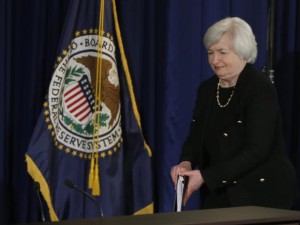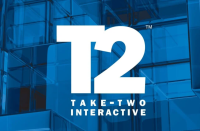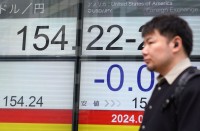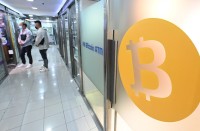
Federal Reserve Board chair Janet Yellen arrives to her news conference in Washington September 17, 2014.
Credit: Reuters/Gary Cameron
WASHINGTON
(Reuters) – Federal Reserve officials nudged their expected path of interest rate increases higher on Wednesday, but did little to change the outlook for a long slow climb back up to normal monetary policy.
The revised rate projections left a deep disconnect between the U.S. central bank and financial markets, with investors anticipating significantly lower rates in the future than the Fed officials themselves project.
The so-called “dots” matrix from the Fed rate setters showed their median view of the appropriate federal funds rate by end-2015 at 1.375 percent versus 1.125 percent in their last projections in June. The end-2016 rate was pushed up to 2.875 percent from 2.5 percent.
By the end of 2017, Fed officials see their target rate back at what they consider a neutral level of around 3.75 percent.
Interest rate futures contract prices reflecting market views, by contrast, have been projecting rates of below 1.0 percent for the end of 2015 and around 2.0 percent at the end of 2016. That could set the stage for a disruptive readjustment if the market has to suddenly catch up.
In a news conference on Wednesday, Fed Chair Janet Yellen noted that the central bank would likely be in an accommodative mode for years to come, but she also said officials would not hesitate to shift gears if conditions warrant.
“It is important for market participants to understand what our likely response or reaction function is to the data and communicate as clearly as we can the way in which our policy stance will depend on the data,” she said.
Some analysts said Yellen’s focus on uncertainty seemed calculated to move investors toward the Fed’s view.
“They want to remind the market that what it has been pricing in is too low. The increase in the dots in June is a pretty good indication that rates will be heading to more normal levels, certainly by end of 2017,” said Stephen Stanley, chief economist at Pierpoint Securities.
IMPLICATIONS RUN DEEP
Once it decides to begin raising interest rates, likely in the middle of next year, the path the Fed follows from there has deep implications for markets and the economy.
Some officials are already concerned that years of low rates have laid the groundwork for a future financial shock, whether because of over-valued asset markets, another consumer credit bubble, or a shakeout in global markets once borrowing costs begin to rise.
In this view, a slow crawl back to normal means years’ more monetary stimulus that could foster trouble.
At the same time, fears about the outlook for global economic growth, potential deflation in Europe, and the lingering scars from the 2008 economic crisis argue for caution.
Mounting evidence of strong U.S. economic growth, and remarks from a number of Fed officials on the possible need to raise rates sooner than previously envisioned, had led investors to reshuffle their expectations in recent weeks.
As result the first policy interest rate increase is now firmly seen as mid-2015, but longer-term expectations on the rate path were almost untouched by the recent market flurry.
A SLOW CLIMB FROM A DEEP HIT
However, the latest Fed projections imply many officials do not expect to raise rates at every policy meeting once the tightening begins. This would be a change from the predictable, strategy of raising rates by a quarter-point-per-meeting the Fed followed in the early 2000s.
It took about four years from the bottom of the 2001 recession for the Fed to return to a neutral policy interest rate. The low point of the last recession was in June 2009, meaning six years may lapse before rates begin to increase, and perhaps three more years before they return to neutral, an eight year span.
Consulting firm Macroeconomic Advisers feels markets are out of step with the Fed. But even that firm’s more aggressive forecast leaves rates at around 3.0 percent at the end of 2016.
“We assume they start slow in the middle of 2015 and give markets some time to adjust to a period of rate hikes again,” said Antulio Bomfim, a senior managing director at the firm. “That gives them an opportunity to see how economic activity reacts.”
(Reporting by Howard Schneider; Editing by David Chance and Clive McKeef)







